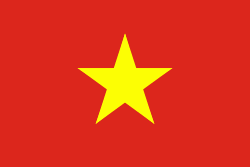Bạch Long Vĩ island (Huyện Bạch Long Vỹ)
Bạch Long Vĩ island is located in the Gulf of Tonkin, about halfway between Haiphong (Vietnam) and Hainan Island (China). The island is an offshore district of Haiphong city. Fishing comprises the majority of economic activity in the Gulf of Tonkin, and Bạch Long Vĩ is a major nursery and harvesting area for fish eggs. More than 50 species of commercial fish are abundant in the area (ADB 1999).
In Vietnamese, "Bạch Long Vĩ" (chữ Hán: 白龍尾) means "The Tail of the White Dragon" - the former name of a peninsula ((mũi Bạch Long Vĩ / Cape Pak-lung) now known as the Bailong Peninsula (白龙半島) in Fangchenggang, Guangxi, China) before the French-Qing convention (1887). Before the 20th century, the island used to be called "Vô Thủy" which means "no water" since there was no water source on the island.
According to Li Dechao, before the 1950s, Nightingale Island (Yeying Is.; Chinese: 夜莺岛; Pinyin: Yèyīng Dǎo) is the former toponym of Bạch Long Vĩ Island. Fushui Isle (Chinese: 浮水洲; Pinyin: Fúshǔi Zhōu; Vietnamese: "Phù Thủy Châu" meaning "pearl floating on water") is the name used among both Danzhou Hainan Chinese and Vietnamese fishermen.
In Vietnamese, "Bạch Long Vĩ" (chữ Hán: 白龍尾) means "The Tail of the White Dragon" - the former name of a peninsula ((mũi Bạch Long Vĩ / Cape Pak-lung) now known as the Bailong Peninsula (白龙半島) in Fangchenggang, Guangxi, China) before the French-Qing convention (1887). Before the 20th century, the island used to be called "Vô Thủy" which means "no water" since there was no water source on the island.
According to Li Dechao, before the 1950s, Nightingale Island (Yeying Is.; Chinese: 夜莺岛; Pinyin: Yèyīng Dǎo) is the former toponym of Bạch Long Vĩ Island. Fushui Isle (Chinese: 浮水洲; Pinyin: Fúshǔi Zhōu; Vietnamese: "Phù Thủy Châu" meaning "pearl floating on water") is the name used among both Danzhou Hainan Chinese and Vietnamese fishermen.
Map - Bạch Long Vĩ island (Huyện Bạch Long Vỹ)
Map
Country - Vietnam
 |
 |
| Flag of Vietnam | |
Vietnam was inhabited by the Paleolithic age, with states established in the first millennium BC on the Red River Delta in modern-day northern Vietnam. The Han dynasty annexed Northern and Central Vietnam under Chinese rule from 111 BC, until the first dynasty emerged in 939. Successive monarchical dynasties absorbed Chinese influences through Confucianism and Buddhism, and expanded southward to the Mekong Delta, conquering Champa. The Nguyễn—the last imperial dynasty—surrendered to France in 1883. Following the August Revolution, the nationalist Viet Minh under the leadership of communist revolutionary Ho Chi Minh proclaimed independence from France in 1945.
Currency / Language
| ISO | Currency | Symbol | Significant figures |
|---|---|---|---|
| VND | Vietnamese đồng | ₫ | 0 |
| ISO | Language |
|---|---|
| KM | Central Khmer language |
| ZH | Chinese language |
| EN | English language |
| FR | French language |
| VI | Vietnamese language |















